Map Object in Python
Map Object in Python

In Python, a map object is an iterator that implements the map function. It takes a function and one or more iterable objects as arguments and returns an iterator that applies the function to each element of the iterable in turn, returning the result.
Creating a Map Object
To create a map object, use the built-in map function. The syntax of the map function is as follows:
map(function, iterable1, iterable2, ...)
Where function is a function, and iterable1, iterable2, … are iterable objects. Here’s a simple example:
# Define a function that multiplies the elements in a list by 2
def double(x):
return x * 2
# Create a map object
numbers = [1, 2, 3, 4, 5]
result = map(double, numbers)
# Print the map object
print(result)
Running the above code prints the following:
<map object at 0x7f7415d79490>
As can be seen from the result, the map function returns a map object.
Accessing Elements of a Map Object
To access elements of a map object, you can use the built-in next() function or directly iterate over the map object. The following example code iterates over a map object:
# Iterate over a map object and print the result
for value in result:
print(value)
Running the above code will yield the result multiplied by 2:
2
4
6
8
10
Comparison with List Comprehensions
In Python, list comprehensions are another common way to operate on iterables. While map objects and list comprehensions have some overlap in functionality, they also have some differences.
Performance
Map objects offer better performance than list comprehensions. This is because map objects are lazy computations, calculating elements only when needed, while list comprehensions evaluate elements immediately and return a new list. For large datasets, using map objects can reduce memory usage and improve efficiency.
Readability
List comprehensions are generally easier to read than map objects. In simple cases, list comprehensions can more clearly express the intended operation. However, for complex operations, using a map object may be more intuitive.
Speed
In some cases, map objects can be faster. This is because map objects are implemented at the C language level, while list comprehensions are implemented in the Python interpreter.
Therefore, in practical applications, the choice between using a map object and a list comprehension should be based on the specific situation.
Using Lambda Functions
When creating a map object, you can use a lambda function to simplify the code. A lambda function is an anonymous function that is typically used for simple operations. The following is an example using a lambda function:
# Use a lambda function to increment the elements in a list by 1
numbers = [1, 2, 3, 4, 5]
result = map(lambda x: x + 1, numbers)
# Iterate over a map object and print the result
for value in result:
print(value)
Running the above code will produce the result after incrementing by 1:
2
3
4
5
6
Lambda functions can make code more concise, but readability and complexity should also be considered.
Notes
There are several things to keep in mind when using a map object:
- A map object is a one-shot iterator and can only be iterated over once. If you need to use the result multiple times, you can convert it to a list or other iterable data structure.
- If the map object’s arguments are multiple iterables, ensure that the iterables are of the same length when calling it; otherwise, unexpected results may occur.
Summary
The Python map object is a convenient and flexible tool for performing various operations on iterables. Using the map object, we can easily process and transform data, improving code readability and efficiency. In practical applications, choosing the appropriate method for processing data based on the specific situation can better leverage Python’s powerful capabilities.